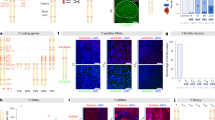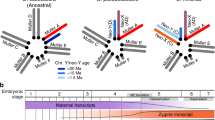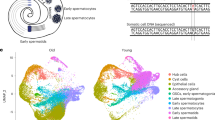Abstract
Heterochromatin suppresses repetitive DNA, and a loss of heterochromatin has been observed in aged cells of several species, including humans and Drosophila. Males often contain substantially more heterochromatic DNA than females, due to the presence of a large, repeat-rich Y chromosome, and male flies generally have a shorter average lifespan than females. Here we show that repetitive DNA becomes de-repressed more rapidly in old male flies relative to females, and repeats on the Y chromosome are disproportionally mis-expressed during ageing. This is associated with a loss of heterochromatin at repetitive elements during ageing in male flies, and a general loss of repressive chromatin in aged males away from pericentromeric regions and the Y. By generating flies with different sex chromosome karyotypes (XXY females and X0 and XYY males), we show that repeat de-repression and average lifespan is correlated with the number of Y chromosomes. This suggests that sex-specific chromatin differences may contribute to sex-specific ageing in flies.
This is a preview of subscription content, access via your institution
Access options
Access Nature and 54 other Nature Portfolio journals
Get Nature+, our best-value online-access subscription
$29.99 / 30 days
cancel any time
Subscribe to this journal
Receive 12 digital issues and online access to articles
$119.00 per year
only $9.92 per issue
Buy this article
- Purchase on Springer Link
- Instant access to full article PDF
Prices may be subject to local taxes which are calculated during checkout




Similar content being viewed by others
Data availability
All RNA-seq and ChIP–seq reads are deposited at NCBI under BioProject ID PRJNA594556.
References
O’Sullivan, R. J. & Karlseder, J. The great unravelling: chromatin as a modulator of the aging process. Trends Biochem. Sci. 37, 466–476 (2012).
Wood, J. G. et al. Chromatin remodeling in the ageing genome of Drosophila. Aging Cell 9, 971–978 (2010).
Tsurumi, A. & Li, W. X. Global heterochromatin loss: a unifying theory of aging? Epigenetics 7, 680–688 (2012).
Zhang, W. et al. Aging stem cells. A Werner syndrome stem cell model unveils heterochromatin alterations as a driver of human aging. Science 348, 1160–1163 (2015).
Larson, K. et al. Heterochromatin formation promotes longevity and represses ribosomal RNA synthesis. PLoS Genet. 8, e1002473 (2012).
Haithcock, E. et al. Age-related changes of nuclear architecture in Caenorhabditis elegans. Proc. Natl Acad. Sci. USA 102, 16690–16695 (2005).
Li, W. et al. Activation of transposable elements during aging and neuronal decline in Drosophila. Nat. Neurosci. 16, 529–531 (2013).
De Cecco, M. et al. Genomes of replicatively senescent cells undergo global epigenetic changes leading to gene silencing and activation of transposable elements. Aging Cell 12, 247–256 (2013).
De Cecco, M. et al. Transposable elements become active and mobile in the genomes of ageing mammalian somatic tissues. Aging 5, 867–883 (2013).
Wood, J. G. & Helfand, S. L. Chromatin structure and transposable elements in organismal aging. Front. Genet. 4, 274 (2013).
Wood, J. G. et al. Chromatin-modifying genetic interventions suppress age-associated transposable element activation and extend life span in Drosophila. Proc. Natl Acad. Sci. USA 113, 11277–11282 (2016).
Van Meter, M. et al. SIRT6 represses LINE1 retrotransposons by ribosylating KAP1 but this repression fails with stress and age. Nat. Commun. 5, 5011 (2014).
Elsner, D., Meusemann, K. & Korb, J. Longevity and transposon defense, the case of termite reproductives. Proc. Natl Acad. Sci. USA 115, 5504–5509 (2018).
Hoskins, R. A. et al. Heterochromatic sequences in a Drosophila whole-genome shotgun assembly. Genome Biol. 3, research0085.1 (2002).
Chang, C. H. & Larracuente, A. M. Heterochromatin-enriched assemblies reveal the sequence and organization of the Drosophila melanogaster Y chromosome. Genetics 211, 333–348 (2019).
Yoon, J. S., Gagen, K. P. & Zhu, D. L. Longevity of 68 species of Drosophila. Ohio J. Sci. 90, 16–32 (1990).
Tower, J. & Arbeitman, M. The genetics of gender and life span. J. Biol. 8, 38 (2009).
Lehtovaara, A., Schielzeth, H., Flis, I. & Friberg, U. Heritability of life span is largely sex limited in Drosophila. Am. Nat. 182, 653–665 (2013).
Pipoly, I. et al. The genetic sex-determination system predicts adult sex ratios in tetrapods. Nature 527, 91–94 (2015).
Hoskins, R. A. et al. The Release 6 reference sequence of the Drosophila melanogaster genome. Genome Res. 25, 445–458 (2015).
Li, X. Y., Harrison, M. M., Villalta, J. E., Kaplan, T. & Eisen, M. B. Establishment of regions of genomic activity during the Drosophila maternal to zygotic transition. eLife 3, e03737 (2014).
Brown, E. J., Nguyen, A. H. & Bachtrog, D. The Drosophila Y chromosome affects heterochromatin integrity genome-wide. Mol. Biol. Evol. https://doi.org/10.1093/molbev/msaa082 (2020).
Bonhoure, N. et al. Quantifying ChIP-seq data: a spiking method providing an internal reference for sample-to-sample normalization. Genome Res. 24, 1157–1168 (2014).
Lu, B. Y., Emtage, P. C., Duyf, B. J., Hilliker, A. J. & Eissenberg, J. C. Heterochromatin protein 1 is required for the normal expression of two heterochromatin genes in Drosophila. Genetics 155, 699–708 (2000).
Carlson, K. A. et al. Genome-wide gene expression in relation to age in large laboratory cohorts of Drosophila melanogaster. Genet. Res. Int. 2015, 835624 (2015).
Garschall, K. & Flatt, T. The interplay between immunity and aging in Drosophila. F1000Res. 7, 160 (2018).
Pletcher, S. D. et al. Genome-wide transcript profiles in aging and calorically restricted Drosophila melanogaster. Curr. Biol. 12, 712–723 (2002).
Chen, H., Zheng, X. & Zheng, Y. Age-associated loss of lamin-B leads to systemic inflammation and gut hyperplasia. Cell 159, 829–843 (2014).
Chen, H., Zheng, X., Xiao, D. & Zheng, Y. Age-associated de-repression of retrotransposons in the Drosophila fat body, its potential cause and consequence. Aging Cell 15, 542–552 (2016).
Tran, J. R., Chen, H., Zheng, X. & Zheng, Y. Lamin in inflammation and aging. Curr. Opin. Cell Biol. 40, 124–130 (2016).
Pindyurin, A. V. et al. The large fraction of heterochromatin in Drosophila neurons is bound by both B-type lamin and HP1a. Epigenetics Chromatin 11, 65 (2018).
Salz, H. K. & Erickson, J. W. Sex determination in Drosophila: the view from the top. Fly 4, 60–70 (2010).
Carvalho, A. B., Koerich, L. B. & Clark, A. G. Origin and evolution of Y chromosomes: Drosophila tales. Trends Genet. 25, 270–277 (2009).
Ganley, A. R. & Kobayashi, T. Ribosomal DNA and cellular senescence: new evidence supporting the connection between rDNA and aging. FEMS Yeast Res. 14, 49–59 (2014).
Sinclair, D. A., Mills, K. & Guarente, L. Accelerated aging and nucleolar fragmentation in yeast sgs1 mutants. Science 277, 1313–1316 (1997).
Lu, K. L., Nelson, J. O., Watase, G. J., Warsinger-Pepe, N. & Yamashita, Y. M. Transgenerational dynamics of rDNA copy number in Drosophila male germline stem cells. eLife 7, e32421 (2018).
Peng, J. C. & Karpen, G. H. H3K9 methylation and RNA interference regulate nucleolar organization and repeated DNA stability. Nat. Cell Biol. 9, 25–35 (2007).
Buchwalter, A. & Hetzer, M. W. Nucleolar expansion and elevated protein translation in premature aging. Nat. Commun. 8, 328 (2017).
Tiku, V. et al. Small nucleoli are a cellular hallmark of longevity. Nat. Commun. 8, 16083 (2017).
Helmrich, A., Ballarino, M., Nudler, E. & Tora, L. Transcription-replication encounters, consequences and genomic instability. Nat. Struct. Mol. Biol. 20, 412–418 (2013).
Greil, F. & Ahmad, K. Nucleolar dominance of the Y chromosome in Drosophila melanogaster. Genetics 191, 1119–1128 (2012).
Tower, J. Sex-specific gene expression and life span regulation. Trends Endocrinol. Metab. 28, 735–747 (2017).
Lyckegaard, E. M. & Clark, A. G. Ribosomal DNA and stellate gene copy number variation on the Y chromosome of Drosophila melanogaster. Proc. Natl Acad. Sci. USA 86, 1944–1948 (1989).
Repping, S. et al. Polymorphism for a 1.6-Mb deletion of the human Y chromosome persists through balance between recurrent mutation and haploid selection. Nat. Genet. 35, 247–251 (2003).
Griffin, R. M., Le Gall, D., Schielzeth, H. & Friberg, U. Within-population Y-linked genetic variation for lifespan in Drosophila melanogaster. J. Evol. Biol. 28, 1940–1947 (2015).
Lemos, B., Branco, A. T. & Hartl, D. L. Epigenetic effects of polymorphic Y chromosomes modulate chromatin components, immune response, and sexual conflict. Proc. Natl Acad. Sci. USA 107, 15826–15831 (2010).
Lemos, B., Araripe, L. O. & Hartl, D. L. Polymorphic Y chromosomes harbor cryptic variation with manifold functional consequences. Science 319, 91–93 (2008).
Sackton, T. B., Montenegro, H., Hartl, D. L. & Lemos, B. Interspecific Y chromosome introgressions disrupt testis-specific gene expression and male reproductive phenotypes in Drosophila. Proc. Natl Acad. Sci. USA 108, 17046–17051 (2011).
Ewing, A. D. & Kazazian, H. H. Jr. High-throughput sequencing reveals extensive variation in human-specific L1 content in individual human genomes. Genome Res. 20, 1262–1270 (2010).
Bosco, G., Campbell, P., Leiva-Neto, J. T. & Markow, T. A. Analysis of Drosophila species genome size and satellite DNA content reveals significant differences among strains as well as between species. Genetics 177, 1277–1290 (2007).
Ellis, L. et al. Intrapopulation genome size variation in D. melanogaster reflects life history. PLoS Genet. 10, e1004522 (2014).
Linford, N. J., Bilgir, C., Ro, J. & Pletcher, S. D. Measurement of lifespan in Drosophila melanogaster. J. Vis. Exp. 71, e50068 (2013).
Alekseyenko, A., Larschan, E., Lai, W., Park, P. & Kuroda, M. High-resolution ChIP-chip analysis reveals that the Drosophila MSL complex selectively identifies active genes on the male X chromosome. Genes Dev. 20, 848–857 (2006).
Langmead, B. & Salzberg, S. L. Fast gapped-read alignment with Bowtie 2. Nat. Methods 9, 357–359 (2012).
Ellison, C. E. & Bachtrog, D. Dosage compensation via transposable element mediated rewiring of a regulatory network. Science 342, 846–850 (2013).
Dobin, A. et al. STAR: ultrafast universal RNA-seq aligner. Bioinformatics 29, 15–21 (2013).
Liao, Y., Smyth, G. K. & Shi, W. featureCounts: an efficient general purpose program for assigning sequence reads to genomic features. Bioinformatics 30, 923–930 (2014).
Love, M. I., Huber, W. & Anders, S. Moderated estimation of fold change and dispersion for RNA-seq data with DESeq2. Genome Biol. 15, 550 (2014).
Eden, E., Navon, R., Steinfeld, I., Lipson, D. & Yakhini, Z. GOrilla: a tool for discovery and visualization of enriched GO terms in ranked gene lists. BMC Bioinformatics 10, 48 (2009).
Supek, F., Bošnjak, M., Škunca, N. & Šmuc, T. REVIGO summarizes and visualizes long lists of gene ontology terms. PLoS ONE 6, e21800 (2011).
Koch, P., Platzer, M. & Downie, B. R. RepARK—de novo creation of repeat libraries from whole-genome NGS reads. Nucleic Acids Res. 42, e80 (2014).
Quinlan, A. R. BEDTools: the Swiss-army tool for genome feature analysis. Curr. Protoc. Bioinformatics 47, 11.12.1–34 (2014).
Kaplan, E. L. & Meier, P. Nonparametric estimation from incomplete observations. J. Am. Stat. Assoc. 53, 457–481 (1958).
Acknowledgements
D.B. was funded by NIH grants (nos. R01GM076007, GM101255 and R01AG057029).
Author information
Authors and Affiliations
Contributions
D.B. and E.J.B. conceived the study and wrote the paper. E.J.B. and A.H.N. collected and analysed the data.
Corresponding author
Ethics declarations
Competing interests
The authors declare no competing interests.
Additional information
Publisher’s note Springer Nature remains neutral with regard to jurisdictional claims in published maps and institutional affiliations.
Extended data
Extended Data Fig. 1 Survivorship curves of additional D. melanogaster strains.
Shown are Kaplan-Meier survivorship curves for line 2549 males and females ((C(1;Y),y1cv1v1B/0 & C(1)RM,y1v1/0) and Oregon-R wild-type males and females.
Extended Data Fig. 2 Genome-wide enrichment of H3K9me2 for replicate young and old D. melanogaster males and females along the different chromosome arms.
Pearson correlation coefficients for replicate H3K9me2 datasets for old males and females, and boxplots of normalized enrichment values for the replicates. Genome-wide plots were generated using biological replicate data as in Fig. 1b,d.
Extended Data Fig. 3 Loss and gain of heterochromatin during ageing.
Shown are chromosomal locations of 50 kb windows that gain (red) or lose (blue) at least 1.5-fold H3K9me2 signal during ageing for males and females. Pericentromeric regions are indicated by the red portion of the line beneath each chromosome.
Supplementary information
Supplementary Information
Supplementary Figs. 1–19 and Tables 1 and 2.
Supplementary Table 3 and 4
Gene expression changes during ageing in (A) XX females, (B) XY males, (C) X0 males, (D) XXY females and (E) XYY males. Enriched GO categories of genes that significantly changed expression during ageing in (A) XX females, (B) XY males, (C) X0 males, (D) XXY females and (E) XYY males.
Rights and permissions
About this article
Cite this article
Brown, E.J., Nguyen, A.H. & Bachtrog, D. The Y chromosome may contribute to sex-specific ageing in Drosophila. Nat Ecol Evol 4, 853–862 (2020). https://doi.org/10.1038/s41559-020-1179-5
Received:
Accepted:
Published:
Issue Date:
DOI: https://doi.org/10.1038/s41559-020-1179-5
This article is cited by
-
Y chromosome toxicity does not contribute to sex-specific differences in longevity
Nature Ecology & Evolution (2023)
-
Why Ys are not necessarily toxic
Nature Ecology & Evolution (2023)
-
Transcriptomes of aging brain, heart, muscle, and spleen from female and male African turquoise killifish
Scientific Data (2023)
-
Sex-limited chromosomes and non-reproductive traits
BMC Biology (2022)
-
Epigenetic conflict on a degenerating Y chromosome increases mutational burden in Drosophila males
Nature Communications (2020)



